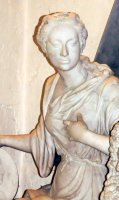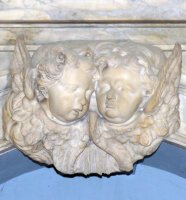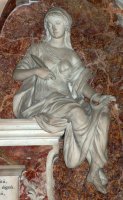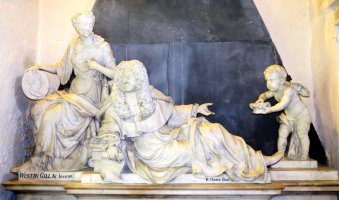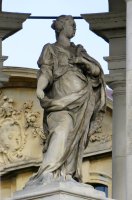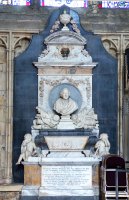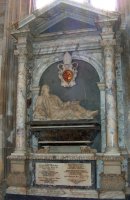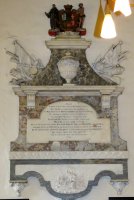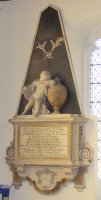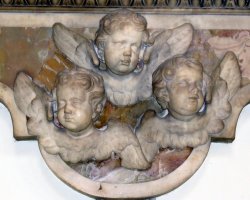Henry Cheere (1703-1781)
The sculptor Henry Cheere was one of the more important English sculptors of the 18th Century, with a goodly number of confirmed works - statues, monuments, and architectural accoutrements such as chimneypieces on the basis of various bills of sale, surviving designs, and signed monuments - and a large number of works which have been attributed to him on stylistic grounds. He was extremely successful, with his sculptural accomplishments launching him towards a knighthood, and then a baronetcy.
The 18th Century sculptor Sir Henry Cheere, Baronet, is important both for the quality of his sculpture, and because he produced a volume of monumental and public sculpture, much of which survives in various towns and churches across England.
He was born in Clapham, south London today but then a northerly part of Surrey, into a well-to-do family, and worked in the Hartshorne workshop, and perhaps for the distinguished John van Nost, before setting up on his own account in workshops in Westminster, near to the Abbey, in what was then called St Margaret’s Lane, the passage from Old Palace Yard to New Palace Yard, which later became today’s St Margaret’s street. He maintained close working with another major Continental sculptor, Henry Scheemakers, until 1733, by which time his practice had grown to significant size, and the 1730s and 1740s - when he moved into Old Palace Yard itself - were marked by his winning major commissions, and being appointed as Stone Carver to Westminster Abbey. His interest in the commercialisation and scaling up of sculptural production developed into a broader prominence in artistic and establishment circles in the capital, leading eventually to his knighthood, and then Baronetcy - a really remarkable mark of establishment recognition for a sculptor, as opposed to a painter.
Example of Cheere's grand figure sculpture.
Henry Cheere’s oeuvre includes major pieces of figure sculpture, including William III for the Bank of England, and several portrait and allegorical figures for Oxford. His church monuments also include grand figure pieces, with reclining nobles and attendant members of their family – it was that period of monumental sculpture when the subject portrayed moved from a stiff, distant figure, to being shown as if in life, relaxing, conversing, surrounded by their kin, with the viewer feeling invited to join in. His figures are accordingly full of movement, bodies turning, looking outwards or towards another figure, hands gesturing, or holding a book, a quill pen, or drapery. Classical of course, but nothing calm and Hellenic here, more Hellenistic, Baroque. Many of his monuments include cherubs too, and these tend to lighter poses, more exaggerated, more Rococo than Baroque.
Figure sculpture by Cheere: Queen Caroline and Henry Medley.
Cheere's production includes a lot of chimneypieces, which once he was successful would doubtless have been carved by stonemasons working to him rather than he himself. For his later monuments, while Cheere would have certainly made the overall designs, it is not possible to know how much of the actual carving is his. In any case, his style was, and perhaps led, the style of many pieces of the time, and it can be difficult to ascribe unproven and unsigned pieces to him or another contemporary sculptor in many cases: many a supposed Cheere piece has at one time or another been ascribed equally confidently to J.M. Rysbrack, his great competitor, or to Roubiliac or Robert Taylor who both worked for him for a time, or indeed to Scheemakers.
Among Cheere’s major figure pieces in the London area, I would note his Westminster Abbey monuments of course, and his group of Robert Raymond and his wife in Abbots Langley, Susannah Thomas and Dame Dorothy Thomas in Hampton, as other accessible examples. Also of note is a standing couple in modern dress which has been ascribed to Cheere more on the basis of the minor ornamentation than the figures themselves, I would think, which is the Cooper monument in West Ham Church. Smaller panel monuments with good sculptural decorations by Cheere or attributed with some confidence to him include John Strange in Leyton Church, the nautical piece to Lord Thomas Bertie in Chislehurst, and an obelisk with cherub to Gascoyne Crisp in Barking.
Richard Willis monument.
Outside London, the best monuments of Cheere I have seen are in Winchester Cathedral - Richard Willis, another grand reclining figure, and a couple of ostentatious panel monuments ascribed to him. Also the bust and cherubs of the Henry Medley monument in York Minster, where the centrepiece of the ship battle carved in relief, and other nautical accoutrements, were recycled in the Bertie piece noted above. In Oxford, notable are his allegorical figures on top of the frontage of Queen’s College to High Street - the three figures on the right hand wing are his, and the portrait statue of Queen Caroline under the cupola, as well as other works within the College grounds.
Cheere’s most significant works date almost exclusively from before 1860, and he retired from active work after about 1770, and died in 1787, the possessor of a considerable fortune. Sculptors working with Henry Cheere who became prominent in their own right include above all Roubiliac, and also Robert Taylor (Sir Robert Taylor, not his eponymous father), and other more minor figures. His brother, John Cheere, was an important sculptor in his own right, his speciality being lead garden figures, which he made in vast quantity, taking over from John van Nost when that sculptor died in 1739.
